
Vaduz is the capital of Liechtenstein and also the seat of the national parliament. The city, which is located along the Rhine, has 5,696 residents. The most prominent landmark of Vaduz is Vaduz Castle, perched atop a steep hill overlooking the city. It is home to the reigning prince of Liechtenstein and the Liechtenstein princely family. The city's distinctive architecture is also displayed in landmarks such as the Cathedral of St. Florin, Government House, City Hall, the National Art Gallery, as well as the National Museum. Although Vaduz is the best-known town in the principality internationally, it is not the largest; neighbouring Schaan has a larger population.
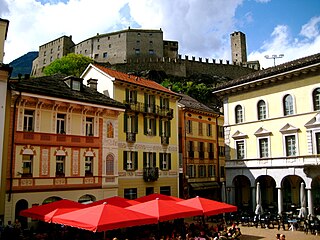
Bellinzona ( BEL-in-ZOH-nə; Italian:[bellinˈtsoːna] ; is a municipality, a historic Swiss town, and the capital of the canton of Ticino in Switzerland. The town is famous for its three castles that have been UNESCO World Heritage Sites since 2000.
Bremgarten District is a Swiss district in the Canton of Aargau, corresponding to the valleys of the Reuss and Bünz rivers in the area known as the Freiamt.

Chillon Castle is an island medieval castle located on Lake Geneva, south of Veytaux in the canton of Vaud. It is situated at the eastern end of the lake, on the narrow shore between Montreux and Villeneuve, which gives access to the Alpine valley of the Rhône. Chillon is amongst the most visited medieval castles in Switzerland and Europe. Successively occupied by the House of Savoy, then by the Bernese from 1536 until 1798, it now belongs to the canton de Vaud and is classified as a Swiss Cultural Property of National Significance.
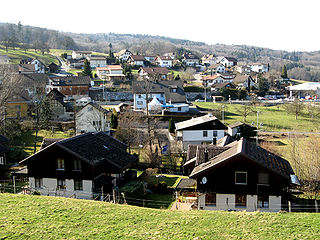
Hilfikon was a municipality in the district of Bremgarten in the canton of Aargau in Switzerland. In January 2010 Hilfikon merged into Villmergen.

Villmergen is a municipality in the district of Bremgarten in the canton of Aargau in Switzerland.

Jegenstorf is a municipality in the Bern-Mittelland administrative district in the canton of Bern in Switzerland. On 1 January 2010 the former municipality of Ballmoos merged into Jegenstorf and on 1 January 2014 Münchringen and Scheunen merged into Jegenstorf.

The Swiss Inventory of Cultural Property of National and Regional Significance is a register of cultural property in Switzerland. It was established according to article 5 of the second protocol to the Hague Convention for the Protection of Cultural Property in the Event of Armed Conflict, which provides for the establishment of national registers of cultural property.
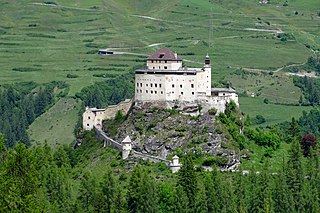
Tarasp Castle is a castle in Switzerland, near the former municipality of Tarasp, in Lower Engadin, Graubünden. It is a Swiss heritage site of national significance.

Rapperswil is a former municipality and since January 2007 part of the municipality of Rapperswil-Jona in the Wahlkreis (constituency) of See-Gaster in the canton of St. Gallen in Switzerland, located between Obersee and the main part of Lake Zurich.

Baden, sometimes unofficially, to distinguish it from other Badens, called Baden bei Zürich or Baden im Aargau, is a town and a municipality in Switzerland. It is the main town or seat of the district of Baden in the canton of Aargau. Located 25 km (16 mi) northwest of Zürich in the Limmat Valley mainly on the western side of the river Limmat, its mineral hot springs have been famed since at least the Roman era. Its official language is German, but the main spoken language is the local Alemannic Swiss-German dialect. As of 2018 the town had a population of over 19,000.
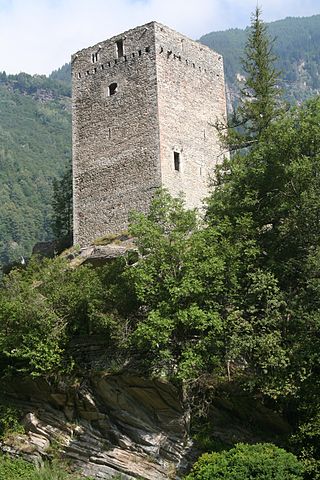
Castelmur Castle is a castle in the village of Bondo in the municipality of Bregaglia of the Canton of Graubünden in Switzerland. It is a Swiss heritage site of national significance. The fortifications at Castelmur may be, after the Three Castles of Bellinzona, the most important example of medieval valley fortifications in modern Switzerland.

Mesocco Castle is a ruined castle in the municipality of Mesocco of the Canton of Graubünden in Switzerland. It is a Swiss heritage site of national significance.
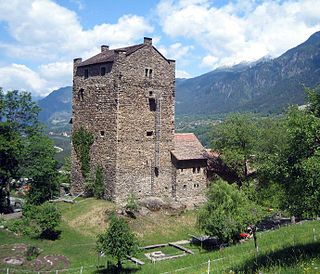
Ehrenfels Castle is a castle in the municipality of Sils im Domleschg of the Canton of Graubünden in Switzerland. It is a Swiss heritage site of national significance. Today it is a youth hostel.
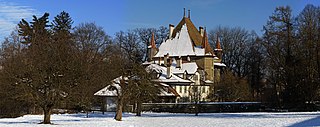
Holligen Castle is a castle in the municipality of Bern of the Canton of Bern in Switzerland. It is a Swiss heritage site of national significance.
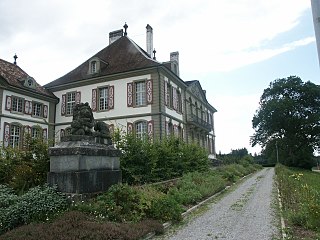
Hindelbank Castle is a castle in the municipality of Hindelbank of the Canton of Bern in Switzerland. It is a Swiss heritage site of national significance. It was sold to the canton in 1866 and later became a workhouse and a prison. Currently, it is the administration building of the only women's prison in Switzerland.

Palazzo Castelmur or Castelmur Castle is a castle in the village of Stampa in the municipality of Bregaglia of the Canton of Graubünden in Switzerland. It is a Swiss heritage site of national significance.

Fliegerstaffel 17 "Falcons" of the Swiss Air Force is a Berufsfliegerkorps squadron of professional pilots flying McDonnell Douglas F/A-18. Together with Fliegerstaffel 6 it forms Fliegergeschwader 11. The home base of the squadron is Payerne Air Base. Fliegerstaffel 17 features a red falcon on a white ground with the black number 17 as its coat of arms.

George Ham Page commonly referred to as General Page was an American industrialist who co-founded the Anglo-Swiss Condensed Milk Company in 1866, a predecessor of Nestlé. He was primarily active in Switzerland. He was the grandfather and namesake of alpine skier George Page.



















